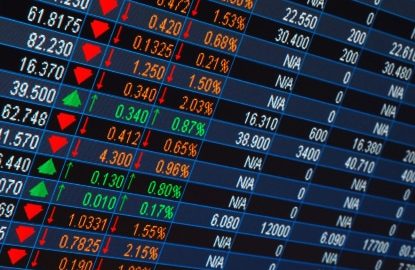Earlier this year the president of the ECB said we would have to get used to elevated levels of volatility. And it is true, the market environment has changed. The years 2009 to 2014 were subject to an asset price reflation regime. High rates of return were coupled with low volatility. This relationship has now reversed. The asset classes are now pricing in the moderate recovery in the industrialised economies, with low expected return amid elevated fluctuation as a rule.
Stabilisation
The financial markets have at least stabilised after the slump at the beginning of last week. The spreads for the default and liquidity risk on the money and capital market have fallen slightly, and the equity prices and the rate of inflation priced in have increased by a bit.
Trigger
The two triggers of the most recent price declines, i.e. the devaluation of the Chinese currency relative to the US dollar, and the expectation of a rate hike in the USA this year, have calmed down. The Chinese central bank has reacted to the market turbulences by slightly strengthening the Chinese currency at the fixing vis-à-vis the US dollar. Also, the actual exchange rate is now not above the fixing anymore, but below it. In the USA the Fed has calmed the markets with cautious statements. The reasons for an increase in the Fed funds rate are not that convincing anymore, according to the central bank.
Rate hike by the Fed still on the agenda
That being said, the Chinese currency might continue to depreciate in the coming months. Also, the US-specific reasons for a rate hike are still the same (improvement on the labour market, growth above potential, inflation target to be reached in the long term). In this context: the ECB also sent out dovish signals (annotation: signals that indicate anything but a tighter monetary policy) last week. The bond purchase programme might be adjusted in terms of volume, duration, and composition. The goals, i.e. a calmer market and another weakening of the euro, were achieved. However, for an actual realignment of the monetary policy, much more would have to happen first.
Deteriorating environment in the emerging markets
What remains is the deterioration of the environment in the emerging markets: higher interest rates, falling exchange rates, high debt in the private sector, weak economic growth, low power of the companies to set prices, and falling commodity prices. Similar to an increase in the key-lending rate, the deterioration of the environment will only be feeding through with a time lag to the emerging economies.
No correction in the industrialised countries
The economic indicators in the industrialised countries suggest the continuation of the moderate economic recovery. Both the USA and the Eurozone are on their path to recovery at growth rates of 2.1% and 1.4% (annualised), respectively, i.e. 0.4 percentage points above potential growth in both cases, in the first half of 2015 (Source: Bloomberg). Since the economic environment has not deteriorated in the industrialised economies, the slumps in the industrialised economies were no actual correction, but can be explained by a general reduction in risk.
Core question
How strong are the spill-over effects from the emerging to the industrialised economies? Two main channels are relevant in this context: the emerging markets export deflationary pressure to the industrialised economies; and the emerging markets export a deterioration of the financial conditions to the industrialised economies. We will have to wait and see whether the economic outlook in the industrialised economies will actually deteriorate.
Positioning
The environment implies a cautious stance vis-à-vis risky asset classes in the industrialised countries, generally high cash ratios, the protection against the risk of deflation with risk-free government bonds, and an abundantly low exposure to emerging markets.
Legal disclaimer
This document is an advertisement. Unless indicated otherwise, source: Erste Asset Management GmbH. The language of communication of the sales offices is German and the languages of communication of the Management Company also include English.
The prospectus for UCITS funds (including any amendments) is prepared and published in accordance with the provisions of the InvFG 2011 as amended. Information for Investors pursuant to § 21 AIFMG is prepared for the alternative investment funds (AIF) administered by Erste Asset Management GmbH pursuant to the provisions of the AIFMG in conjunction with the InvFG 2011.
The currently valid versions of the prospectus, the Information for Investors pursuant to § 21 AIFMG, and the key information document can be found on the website www.erste-am.com under “Mandatory publications” and can be obtained free of charge by interested investors at the offices of the Management Company and at the offices of the depositary bank. The exact date of the most recent publication of the prospectus, the languages in which the key information document is available, and any other locations where the documents can be obtained are indicated on the website www.erste-am.com. A summary of the investor rights is available in German and English on the website www.erste-am.com/investor-rights and can also be obtained from the Management Company.
The Management Company can decide to suspend the provisions it has taken for the sale of unit certificates in other countries in accordance with the regulatory requirements.
Note: You are about to purchase a product that may be difficult to understand. We recommend that you read the indicated fund documents before making an investment decision. In addition to the locations listed above, you can obtain these documents free of charge at the offices of the referring Sparkassen bank and the offices of Erste Bank der oesterreichischen Sparkassen AG. You can also access these documents electronically at www.erste-am.com.
N.B.: The performance scenarios listed in the key information document are based on a calculation method that is specified in an EU regulation. The future market development cannot be accurately predicted. The depicted performance scenarios merely present potential earnings, but are based on the earnings in the recent past. The actual earnings may be lower than indicated. Our analyses and conclusions are general in nature and do not take into account the individual characteristics of our investors in terms of earnings, taxation, experience and knowledge, investment objective, financial position, capacity for loss, and risk tolerance.
Please note: Past performance is not a reliable indicator of the future performance of a fund. Investments in securities entail risks in addition to the opportunities presented here. The value of units and their earnings can rise and fall. Changes in exchange rates can also have a positive or negative effect on the value of an investment. For this reason, you may receive less than your originally invested amount when you redeem your units. Persons who are interested in purchasing units in investment funds are advised to read the current fund prospectus(es) and the Information for Investors pursuant to § 21 AIFMG, especially the risk notices they contain, before making an investment decision. If the fund currency is different than the investor’s home currency, changes in the relevant exchange rate can positively or negatively influence the value of the investment and the amount of the costs associated with the fund in the home currency.
We are not permitted to directly or indirectly offer, sell, transfer, or deliver this financial product to natural or legal persons whose place of residence or domicile is located in a country where this is legally prohibited. In this case, we may not provide any product information, either.
Please consult the corresponding information in the fund prospectus and the Information for Investors pursuant to § 21 AIFMG for restrictions on the sale of the fund to American or Russian citizens.
It is expressly noted that this communication does not provide any investment recommendations, but only expresses our current market assessment. Thus, this communication is not a substitute for investment advice, does not take into account the legal regulations aimed at promoting the independence of financial analyses, and is not subject to a prohibition on trading following the distribution of financial analyses.
This document does not represent a sales activity of the Management Company and therefore may not be construed as an offer for the purchase or sale of financial or investment instruments.
Erste Asset Management GmbH is affiliated with the referring Sparkassen banks and Erste Bank.
Please also read the “Information about us and our securities services” published by your bank.
Subject to misprints and errors.



